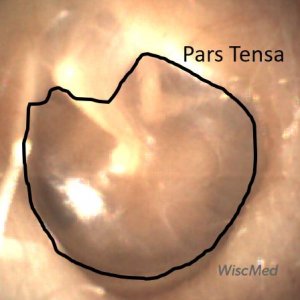
Pars Tensa and Pars Flaccida
A 25 year old medical student is on her internal medicine rotation. She has questions about ear anatomy after examining her 11 AM patient. She obtained this image using the Wispr otoscope and would like to understand the difference between the pars tensa and the pars flaccida portions of the tympanic membrane.
There are two distinct areas to the tympanic membrane (eardrum), the pars flaccida and the pars tensa.
These two areas are outlined in the following images:


The pars tensa is the portion of the tympanic membrane that is the largest. It’s what people tend to think of when they think of the “eardrum.” As the name suggests, it is “taut,” much like if you stretched plastic wrap on top of a bowl. You could also imagine the pars tensa to be similar to a drum surface. It is the portion of the eardrum responsible for translating sound waves into mechanical movement.
The pars flaccida, as the name suggests, is less “taut” and also thicker. It drapes across the superior portion of the malleus. Although it does not have an active role in sound wave transcription, it is necessary to provide complete coverage of the middle ear space and allow for the proper functioning of the pars tensa.
From a clinical perspective, the pars tensa gets most of our attention. This is the place where we would expect to see perforations, effusions, and the characteristic bulging of acute otitis media.
The pars flaccida may be the first place that bulging of the tympanic membrane is seen due to increased pressure in the middle ear space. The pars flaccida is where most eardrum movement would be appreciated if evaluating mobility of the eardrum via either pneumatic otoscopy or a Valsalva maneuver.
Bonus: Which ear is this? It is the left ear.







































































































































































































